Lead Weather Presenter
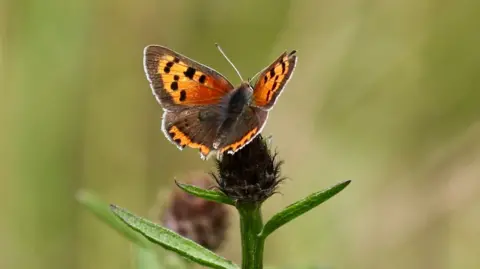 Frank Gardner
Frank GardnerCertain insects – including ladybirds, butterflies and wasps – are thriving after the warmest and sunniest spring on record across the UK.
Aphid numbers, the main food source of ladybirds, boomed according to the Royal Horticultural Society after a warm start to the summer.
But the relative lack of rain this spring and summer could lead to lower insect and amphibian numbers next year since eggs may not be laid and wetland areas are drying up.
Insect numbers are difficult to quantify but research suggests that in the longer term, the UK’s flying insect population is in decline.
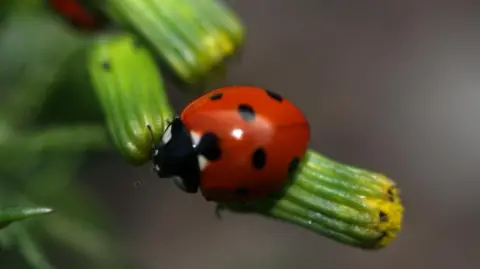
An abundance of aphids
Whilst the long term picture for the decline of flying insects looks pretty bleak, there is no denying that this year has been a visibly bumper one.
Kathryn Brown is director of climate change and evidence at The Wildlife Trusts, a federation of 46 independent wildlife conservation charities in the UK.
She said: “Many people across the UK are noticing more ladybirds, wasps and other insects this summer – off the back of a very poor year last year for species like butterflies.”
These are all species that thrive in warm, dry conditions.
Earlier in the year the Royal Horticultural Society correctly predicted that we were in for an abundant year for aphids. Whilst that has proved a bit of a headache for gardeners, aphids form an important part of the food chain and are eaten by birds and other insects.
Dr Hayley Jones, principal entomologist at the Royal Horticultural Society, says that their numbers are now beginning to drop off as their natural predator – the ladybird – is taking over and playing catch up.
‘Extraordinary’ year for early butterfly sightings
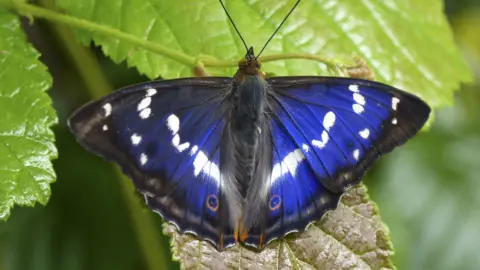 PA Media
PA MediaAnother much loved flying insect, the butterfly, is often seen as an important indicator of the general health of the immediate environment. These have been in general decline since the 1970s.
Dr Richard Fox, head of science at the Butterfly Conservation charity, says that 2025 has been quite extraordinary in terms of early sightings with 18 species spotted at least two weeks earlier than average and a further 24 species seen at least a week early.
This is in contrast to last year’s ‘butterfly emergency’, declared when the lowest numbers of butterflies were ever recorded. This followed a cloudy, wet spring and cool summer. Some varieties, such as the dark green fritillary did not have a single sighting in 2024.
Butterflies, like all insects, are ectothermic (cold-blooded) and need the warmth and light of the sun to regulate their body temperature and give them energy to fly.
This year’s warmth has helped them move through their lifecycle quickly meaning their survival rate has been remarkably good; spending less time as caterpillars and as potential bird food.
Lepidopterist Martin Wills, who records numbers at Hutchinson’s Bank Nature Reserve in south London, confirmed that it has been a fantastic butterfly season so far with record numbers of early sightings.
Bumper year for lavender
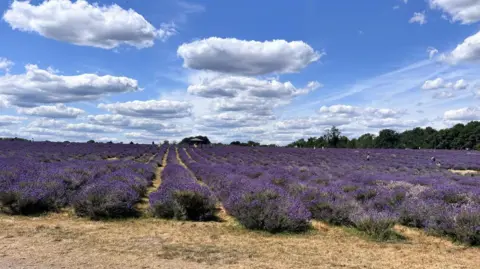
Not far from Hutchinson’s Bank Nature Reserve in south London lie some of the UK’s most beautiful lavender fields.
Lavender thrives in sunny, warm conditions with dry summers and mild winters.
This year in the UK it has come into full bloom much earlier than usual, attracting more bees and butterflies earlier in the year. Lorna May, the owner of Mayfield Lavender in Surrey, told BBC Weather she had seen a tenfold increase on last year in honey production which she put down to the happy and soaring bee population.
But the number of pests have increased too including the tiny, shiny rosemary beetle which has exploded in number this year. To avoid using pesticides, an army of volunteers remove the beautiful bugs by hand.
One cause for concern of an early lavender bloom for Lorna May is that the plant may die earlier and this could in turn have a notable effect on the local biodiversity for the rest of the summer.
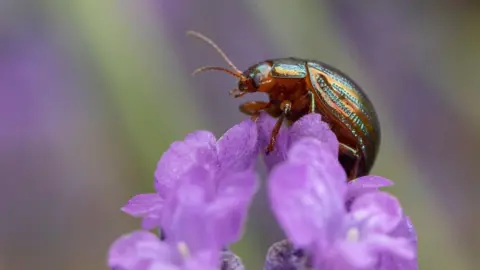 Dan Kitwood/Getty Images
Dan Kitwood/Getty ImagesAccording to Kathryn Brown of The Wildlife Trusts, climate change is making things more chaotic for nature.
She said: “We’re waiting to see the statistics for this year, but it’s likely that we are seeing greater ‘boom and bust’ cycles for wildlife as we experience increasing erratic weather patterns.”
The latest State of the UK Climate report published by the Met Office remarks that weather extremes are now becoming the new normal and that hotter, drier summers will become more frequent.
Eight of the 10 warmest UK springs have occurred since 2000, with the three warmest since 2017.
Of course, wildlife are sensitive not only to weather extremes but also to the use of pesticides and loss of ecologically varied habitats – for example a rise in monoculture planting and non-native plant species.
It is often overlooked how important insects are to OUR biodiversity, playing vital roles in almost every ecosystem. From pollination, to being an essential food source, to helping the decaying process.
The Wildlife Trusts suggests you can help declining populations by mowing your lawn less often, supporting local rewilding projects and creating ponds.

